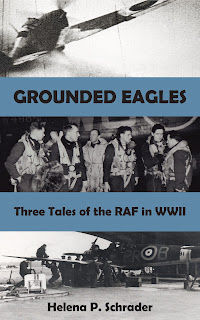Machines - Wellington
The Wellington, like the Whitley, was a medium bomber pressed into service in 1938, at a time when it was already becoming obvious it was inadequate for the job. The world had changed too rapidly and Britain, a fundamentally pacifist nation in the interwar years, found itself confronting an increasingly militant -- and well-armed -- Nazi Germany.
Yet if the Wellington was not the bomber that would win the war, it was versatile and well-designed. It would prove more valuable and enduring than the Witney and Hampdem, and did valuable service to the end of the war.
Although designed to the same specifications as the Whitney, the Wellington was notably different. It was the brain-child of Barnes Wallis, an engineer most famous for his innovative bombs such as the bouncing bombs used on the Ruhr dams and the massive "earth-quake" bombs used at the end of the war. His major contribution to the Wellington was the use of a geodetic air frame, which is based on the concept of intersecting arcs on a curving surface, or a woven metallic framework for the fuselage. (See below.)
At the outbreak of the war, eight squadrons were equipped with Wellingtons, and Wellingtons flew the very first RAF bombing raid of the war on September 4 (one day after the official declaration of war), when 14 Wellingtons took part in a daylight raid against German shipping. Two Wellingtons failed to return, becoming the earliest casualties in the war. The Wellingtons were deployed repeatedly against shipping after that, with only minimal success, and by December 1939 their vulnerability to German day fighters was impossible to overlook. In 1940, Wellingtons were switched to night operations and after crews had been trained they took part in the first raid on Berlin on 25 August 1940. In the first "thousand bomber raid" flown by the RAF on May 30, 1942, Wellingtons made up 599 aircraft of the total force of 1,046.
As more and more four-engine heavy bombers came into service, the Wellington was gradually withdrawn from front-line service in Bomber Command, but it remained a vital component of the RAF's establishment. Wellingtons saw service in North Africa and the Near East, where Wellingtons based in India formed Britain's first long-range bomber force in that theater. They also preformed a vitally important function in Coastal Command as submarine hunters and mine-layers over the North Atlantic and Mediterranean. In late 1944, a Wellington was modified to carry sophisticated airborne radar and used as an airborne early warning and control aircraft guiding Mosquitos and Beaufighters to intercept V1 being launched at Britain. Wellingtons also found service in Transport Command.
Yet without doubt the most vital role played by Wellingtons in the last three years of the war were as training aircraft. The vast majority of Operational Training Units, where fledgling pilots who had only flown light, training aircraft were introduced to bombers -- and working together with a crew. No matter what heavy bomber they later flew, nearly all aspiring Bomber Command pilots flew the "Wimpy" (as the Wellington was affectionately called after a cartoon character). "Stevie" Stevens called it "the backbone of training for Bomber and Coastal Commands." [Jonny Cracknell and Adrian Stevens, Tomorrow May Never Come, Wing Leader Ltd., 2021, 180.]
For the greater part of the war, RAF Bomber Command was viewed by civilians and aircrew alike as the only means of striking back at Hitler for the damage, destruction and misery he had inflicted.
My novels about the RAF in WWII are intended as tributes to the men in the air and on the ground that made a victory in Europe against fascism possible.
Riding the icy, moonlit sky,
they took the war to Hitler.
Their chances of survival were less than fifty percent.
Their average age was 21.
This is the story of just one bomber pilot, his crew and the woman he loved.
It is intended as a tribute to them all.
or Barnes and Noble.

"Where Eagles Never Flew" was the the winner of a Hemingway Award for 20th Century Wartime Fiction and a Maincrest Media Award for Military Fiction. Find out more at: https://crossseaspress.com/where-eagles-never-flew
For more information about all my aviation books visit: https://www.helenapschrader.com/aviation.html








Comments
Post a Comment